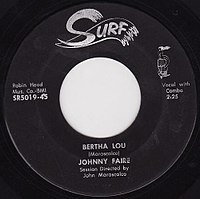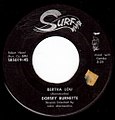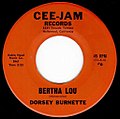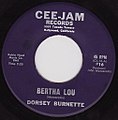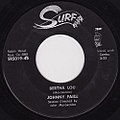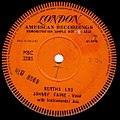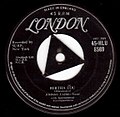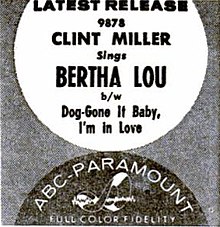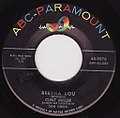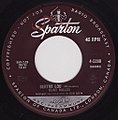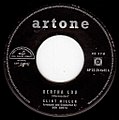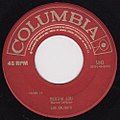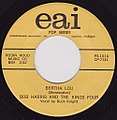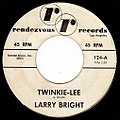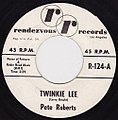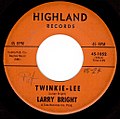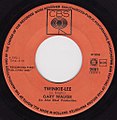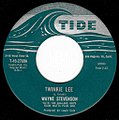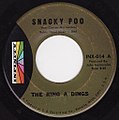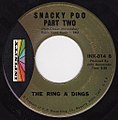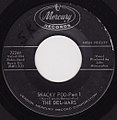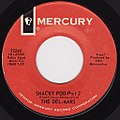Bertha Lou
| Bertha Lou | |
|---|---|
| Johnny Faire | |
| publication | December 9, 1957 |
| length | 2:27 |
| Genre (s) | Rockabilly |
| Author (s) |
Johnny Burnette , John Marascalco |
| Publisher (s) | Robin Hood Music |
| Label | Surf Records |
| Cover versions | |
| 1957 | Clint Miller |
| 1966 | Gary Walker |
Bertha Lou is a Rockabilly - Song , the first time in 1957 in the recording of Johnny Faire was published. An initially recorded version by Dorsey Burnette had to be withheld for contractual reasons. The piece was written by Johnny Burnette together with the songwriter and publisher John Marascalco . The song, which is both lewd and parody, is based on a fast and hard played blues and is easy to recognize due to its distinctive guitar riff . After a few contemporary cover versions , of which Clint Miller's hit the American Billboard charts in 1958 , as well as adaptations to Twinkie Lee , Snacky Poo and finally Bob Dylan's adaptation Rita May , the title became a much-played standard of neo-rockabilly and psychobilly from around 1980 -Scene.
Emergence
The brothers Johnny and Dorsey Burnette moved to California after their band "The Rock 'n' Roll Trio" broke up in the middle of 1957, where they hoped to make a name for themselves on the one hand as songwriters and on the other as solo performers and together as " Burnette Brothers ”became active. From Memphis they knew the Mississippi-born songwriter John Marascalco, who had been doing well since March 1956 with compositions for Little Richard at Specialty Records . The Burnettes visited the songwriter with their guitarist Odell Huff in his apartment and Johnny introduced him to the first verse of a new song idea, which they worked out together for Bertha Lou . Because Johnny needed money to pay for his rent, he sold Marascalco his share of the author's rights. Years later, Johnny's son Rocky Burnette put the sale at $ 50. Such cut-ins were a common business practice in the music industry at the time. On October 27, 1957, Marascalco had the full copyright to Bertha Lou secured by the entry in the Library of Congress and took over the song on his own recently founded music publisher Robin Hood Music.
In November 1957, Marascalco arranged a recording session in the Studio Master Recorders for the small label Surf Records by Kenny Babcock , whose son Keith, however, remembers the Goldstar Recording Studios as the recording location. The band hired Odell Huff on guitar, Danny Flores on piano and HB Barnum on drums. Dorsey Burnette probably took over the bass himself. Johnny Burnette supported the percussions with handclaps . The song was recorded in several takes under Marascalco and Babcock's direction . Keith Babcock remembers that his father retuned the guitar while it was being recorded so that its range increased and Odell Huff could play his part on a single bass string. Already during the preparation of the session it was noticed that Johnny Burnette was still under contract with Coral Records and was therefore not allowed to make recordings as the main artist for another record company. His voice was therefore removed from a first demo recording and Dorsey Burnette sang the title again. But Johnny Burnette's vocal contribution was retained: On the one hand, his vocal track can still be heard softly in the background, especially at the beginning of the second verse when Dorsey Burnette gets out of step, on the other hand he loudly fires Odell Huff with the shouts “Rock! Skirt! Rock! ”To the guitar solo. Together with the rockabilly title Til the Law Says Stop written by Marascalco as the B-side, Dorsey Burnette's version was mastered for publication on Surf Records under the record number SR5019-45 and the first edition was produced in the company's own press machine.
Shortly thereafter, Dorsey Burnette admitted to Marascalco's displeasure that he too had an ongoing contract that forbade him to record for other record labels. Since a release of the record was thus obsolete, Marascalco and Babcock decided to let the song again be sung by another artist. The choice fell on the young Johnny Faircloth , who had to learn the songs overnight for the session scheduled for the next day. Faircloth was based heavily on Dorsey Burnette's vocals and was able to complete the new recording of Bertha Lou in the presence of the Burnettes after a few takes. For Til The Law Says Stop, there were no separate audio tracks for instrumental and vocal work, so Faircloth had to sing over Dorsey Burnette's voice as precisely as possible, which made the session lengthy and arduous. In particular, Dorsey Burnette's southern accent and its metric freedom bothered the man from the west coast. The double melody voice can therefore be clearly heard on the recording.
Musical structure
While the music edition of 1957 suggested G major as the basic key, the musicians of the original version Bertha Lou built on a 12-bar blues in 4/4 time in E major : Four bars of tonic are followed by two bars of subdominant and again two bars of tonic . With a dominant bar and a subdominant bar, two bars of tonic complete the blues scheme. The eight-bar bridge also only varies these three functional harmonies: Two bars of subdominant are followed by two bars of tonic, then again two bars of subdominant and finally two bars of dominant. Each stanza is preceded by a 2/4 time signature on the tonic, which has the extended prelude “Bertha Lou, Bertha Lou” or “Hey! Hey Bertha Lou! ”Picks up. Like the stanzas, the guitar solo consists of a 12-bar scheme, but does not need this intermediate bar. Intro and outro open and end the song on the tonic. The entire sequence of the song with AAB structure looks like this in the two original versions by Dorsey Burnette and Johnny Faire:
- Intro (4 bars)
- 1st stanza (2/4 bar + 12 bars)
- 2nd stanza (2/4 bar + 12 bars)
- Bridge (8 bars)
- 3rd stanza (2/4 bar + 12 bars)
- Guitar solo (12 bars)
- Bridge (8 bars)
- 3rd stanza (2/4 measure + 1/2 measure)
- Outro (8 bars) and fade-out
On all three chordal steps of the verse, a distinctive riff is played on the bass strings of the guitar, which strikes twice the root note in ascending eighth notes, above the minor third and the fourth and finally arrives in individual eighth notes via the diminished fifth on the fifth. In the manageable set of notes of the sung melody, the root E and the associated minor third G also dominate. The use of these thirds based on the blue notes gives the song its bluesy minor character, especially since the major key on which the song is based is only very hidden from the piano as seventh chords is played in the background. On the tenth bar of a verse - the subdominant - the rhythm section is silent and the electric guitar plays a descending fill-in .

The stanzas consist of six verses each with the rhyme scheme [aabbaa]. The dominant, blunt end rhyme (a) is the assonance on - [u] of the syllables "Lou", "you", "do" and "ooh", which are used several times, each in two pairs of the assonance or the rhymes "sand" “Man”, “moan” - “phone” and “wild” - “child” in the middle of the three stanzas (b). The six final syllables always fall on the first beat of the first, third, fifth, seventh, ninth and eleventh bars of the blues scheme. The actual song text is sung in a rhythmic variant typical of the blues, for example in the function of polysyllabic upbeats before the first beat. Between the verse and the guitar riff, which starts on this first beat of the measure, a dialogue develops, especially since the riff following the verse can be heard in full without overlaying vocals. The next verse begins on the second beat of the following bar at the earliest and metrically follows the fast eighth notes of the newly started guitar riff - sometimes equalized by quarter notes. Only the fifth verse of the stanzas does not end on the first beat of the ninth measure, but rather, in melismatically connected notes , draws a descending major triad into the subdominant of the tenth measure. The descending fill-in of the electric guitar responds to this vocal climax of the melody. This call and response is a fundamental principle of Afro-American-influenced popular music, is presented here between voice and guitar and finds its content equivalent in the sexually charged text and the aggressiveness of the amplified guitar sound. The four-verse bridge makes do with the two rhymes "cut" - "truck" and "sweet" - "feet" and uses the full eight bars without significant pauses.
Some cover versions and adaptations change the mood and structure in details: Don Costa arranged the song for Clint Miller without the 2/4 time, which he only used before the third verse. In Bertha Lou der Fendermen and in Twinkie Lee the first interval of the guitar riff became the major third E-G sharp, which corresponds to a major tuning. In various recordings, the guitar riff is also taken over by the electric bass.
content
Bertha Lou joins a series of well-known songs from rock 'n' roll and rockabilly whose title corresponds to or contains a woman's name. Allegedly, Dorsey Burnette's wife Alberta had to serve as the namesake of the sung-about Bertha Lou . Many of these “Songs about Girls' Names” have a distinct sexual connotation. In the third stanza of Bertha Lou it says:
|
|
The unusually biologistic verb to conjugate (German: to pair) in the first version of the song prompted promoter Dick Clark to boycott the title in radio programs and live shows that he organized. Stuart Colman reads from this text an expression of particular virility that resembles the elephant in a china shop. John Marascalco chose the less suggestive term to congregate (German: to come together) for printing the music edition . Most of the performers who followed followed this careful defusing.
Richard Aquila, referring to Clint Miller's chart version, recognizes the humorous potential in the exaggerated text of the narrative rockabilly protagonist: “Even at the time of publication, you didn't know whether it was a parody of a woman's name rockabilly song or whether it was a serious contribution to the Repertoire of the genre is intended. "This is the text of the bridge:
|
|
Craig Morrison sees a “heavy” humor in the last verse of the Bridge, which benefits from the “contrast between bizarre and inappropriate texts and the serious lecture”, and represents a characteristic of the genre, since “almost everything is violent” in rockabilly.
Publications
For the release of the newly recorded version on December 9, 1957, Kenny Babcock chose Faircloth's more concise stage name "Johnny Faire" and the same record number SR5019-45. On the same day the record was discussed in Billboard Magazine . A special feature was the accompanying paper sleeve on which the record was advertised by specifying further compositions by John Marascalco. Ahead of its time was the label reference to Marascalco as a producer, who later regretted that he did not get a share of the sales for this job. The first edition of Surf SR5019-45 by Dorsey Burnette was withheld and destroyed. Only one box is said to have remained, so that a few copies found their way into record collections. Johnny Faires Surf SR5019-45 received so much attention that it was reissued in 1958 as Quality K-1696 for the Canadian market and as the London HLU 8569 for the British market. In the 1970s, Surf 5019 from Johnny Faire appeared in an unauthorized new edition in the original guise, recognizable by the incised "Re" abbreviation in the area of the outlet groove . Bertha Lou's sheet music was published by Marascalco's Robin Hood Music publisher in collaboration with Rio Grande Music from Texas. The sales of the sheet music were taken over by the publishing house Hill & Range as the sole commercial agent .
In the mid-1960s, Marascalco, in consultation with Dorsey Burnette, decided to release the originally withheld version on his own small label, Cee-Jam Records . In addition, Dorsey recorded the blues classic Keep A-Knockin ' , which appeared as the B-side of Cee-Jam # 6 under the band name "The Brothers". Around 1970, Bertha Lou's original compilation of Cee-Jam # 16 with Til the Law Says Stop was re-released in a small edition of 2,000 copies at the suggestion of Ronny Weiser , the operator of the rockabilly label Rollin 'Rock . The title never appeared on any of Dorsey Burnette's official albums. It was not until the 1990s that the complete works of the Burnette Brothers were prepared by means of work editions in CD and CD box format that the title could again be made available to a broader audience.
- 1957 - Johnny Burnette (unreleased demo recording)
- 1957 - Dorsey Burnette on Surf SR5019-45 (unreleased), then in 1965 on Cee-Jam # 6 and 1970 on Cee-Jam # 16
- 1957 - Johnny Faire on Surf SR5019-45 and 1958 on Quality K-1696 and on London HLU-8569, the latter also as a 10-inch shellac single and as a promotional edition on London MSC 2285
Cover versions
Even before the official release, the record company ABC-Paramount became aware of the song and made Babcock an offer for the master tapes. Since the latter refused, Clint Miller played their new signing on November 20, 1957 under the direction of Don Costa a first cover version for ABC, for which he must have resorted to a demo version. This resulted in some deviations in the text. Miller's cover version was featured in the same Billboard issue as the original. Promptly was Bertha Lou also from the rockabilly band The Fendermen their LP Mule Skinner Blues , by Alan Knight and Bob Harris and the Kings Four gecovert from Michigan. With Los Salvajes from Mexico and Los Zodiac from Peru, bands from Latin America also picked up the song and presented Spanish-language versions with a text by Manuel Callegos. The British rock 'n' roll musician Marty Wilde put on a retrospective album in 1970 about the time of his greatest successes and also played Bertha Lou on it .
- 1957 - Clint Miller on ABC-Paramount 78- and 45-9878, in Canada on Sparton for 78 turns on 528-R and for 45 turns on 4-528R, in Sweden on Karusell KFF 223, in the Netherlands on Artone AP 22.014
- 1960 - The Fendermen on the album Mule Skinner Blues , Soma MG-1240, in Canada 1961 on Point Records P-213
- 1960 - Alan Knight on Tide Records T-0011
- 1961 - Los Salvajes on Columbia 5043
- 1962 - Bob Harris and the Kings Four on EAI PS-101
- 1963 - Los Zodiac on Odeon del Peru 8825
- 1970 - Marty Wilde on the album Born to Rock 'n' Roll , Philips 6308 010
1979 Johnny Burnette's son Rocky took on the title of his father and uncle for the first time and started a series of cover versions in the style of the growing neo-rockabilly and psychobilly scene, which became aware of the song with the driving riff. Since then, the title has been recorded and released in at least 40 versions, including 2004 by the rockabilly band Los Gatos from Mexico and in 2009 by Las Ondas Marteles again in Spanish versions. There are several versions of Robert Gordon , Rocky Burnette , Tav Falco's Panther Burns , the Astro Zombies and the Meteors , including live performances. Bertha Lou has had the latter in her live repertoire since her early career, so there are various bootlegs that are not included in the following list.
- 1979 - Rocky Burnette on the album Son of Rock 'n' Roll , EMI EMC3323
- 1979 - The Customs on Long Gone album
- 1981 - The Urbations on an EP from Wild Child Records
- 1983 - Tav Falco's Panther Burns on Blow Your Top EP , Rough Trade RT-114T
- 1983 - The Memphis Rockabilly Band with Jeff Spencer on the private label MRB and on the album Bertha Lou
- 1986 - Die Freie Garage on the album Speedmeat , White Noise 15061
- 1989 - Tav Falco's Panther Burns on the live album Midnight in Memphis , New Rose Records 185
- 1991 - The Meteors on the album Madman Roll , Sonovabitch ROTT 90022
- 1992 - Johnny and the Headhunters on Real Rock N Roll album
- 1992 - The Meteors on the live album Live 4 ... International Wreckers , Sonovabitch ROTT 90062
- 1993 - Colin Winski on the album Helldorado , Fury FCD-3027
- 1995 - Los Marauders on Every Song We Fuckin 'Know , Teenbeat 122
- 1996 - Hot Stuff on the album Only For Hep Cats , Tail T-10-1
- 1997 - Robert Gordon on the album Robert Gordon , Llist LLT 00792
- 1997 - The Astro Zombies on the album The Astro Zombies Are Coming , Banana Juice Records (first version)
- 1999 - The Meteors on the album John Peel Session , Raucous RAUC 044 ( recorded for the BBC in 1985 )
- 1999 - The Bottletones on Corn Rampin ' album , Relay Records
- 2000 - Junior Marvel on the album Early and Unreleased , Rundell CD / LP 023
- 2001 - The Rockin '8 Balls on the album Eight Balls O'Fire , Goofin' 6108
- 2001 - Rudy LaCrioux & The Allstars on the album Let's Have a Ball , Nervous
- 2001 - Rocky Burnette , Darrel Higham & The Enforcers on Hip Shakin 'Baby album , Rockstar Records RSRCD-021
- 2002 - Robin Sylar under the spelling Bertha Lu on the album Bust Out , Race Records and TopCat Records
- 2003 - The Meteors on the live album From Beyond , Raucous RAUCLP 124 (recorded in the 1980s)
- 2003 - Bell Hops on the album Wild, Wet and Juicy , ROCKCD-9416
- 2003 - Ratso & Switchblade on the album Playing with Rats , Sphincter 312
- 2003 - The Astro Zombies on the album Mutilate, Torture and Kill , Nova Express (second version)
- 2003 - Bloodshot Bill on Trash Addict , Fake Records
- 2004 - Los Plantronics on the album La Orchestra Diabolica , Mariachi Productions 004
- 2004 - The Hicksville Bombers on the album The Devil Made Us Do It , Raucous CD RAU 153
- 2004 - Alan Leatherwood on the album Rock, Bop, Folk and Pop Vol. 1 Featuring Remember the Alamo , Ohio Moon
- 2004 - Los Gatos on the album Lo Que Mata, No Es el Auto , Grabaciones Alicia GACD-018
- 2004 - Jeff Simmons on the album Blue Universe , Blue Fox Records
- 2005 - Robert Gordon & Chris Spedding on the live album Rockin 'the Paradiso , Last Call CD / DVD 3113142
- 2005 - Atomic Hi-Tones on the EP Wolfcat , Twaino Records
- 2006 - The Astro Zombies on the live album Burgundy Livers , Raucous
- 2007 - RJ and the Phantoms on the album What's the Rumor , Red Shoot Records CD RS 100
- 2007 - Hellcats on the album I've Got a Devil Inside , Tedly Serious TED CD-102
- 2007 - Blue Rockin ' on the album Rockin Boogie Trash , Part CD 660002
- 2007 - Robert Gordon with Link Wray and Danny Gatton on the live album Lotta Lovin ' , Climate Change CD 004 (recorded 1983)
- 2008 - Mike Mok and the Em-Tones on the Compilation Worldwide Rockabilly Vol. 1 - Let's Kill Someone , Louisiana Records LR 5001
- 2009 - Las Ondas Marteles on the album On Da Rocks , Because
- 2010 - Homer Henderson on the album Used Without Permission , Lulie 105
- 2010 - Gru-V-Tones featuring Boppin 'Bettie on the sampler Finnish Rock' n 'Roll 2010 , Talsti EDCD1008
- 2011 - Bird Doggin 'Daddies on the album Hopped Up , Rhythm Bomb
- 2011 - Carlos Mejuto on the album Carlos Mejuto , Wild
- 2011 - The Boothill Stompers on the album Goin 'Our Own Way
- 2014 - Mike Sanchez on the album So Many Routes
- 2015 - The Dyna Jets on the limited maxi single The Calling , Mandinga Records MNDG 004
- 2017 - Lucky 13 on the album Trouble & Love , Part Records
Adaptations
Twinkie Lee
In 1960, Californian singer Julian "Larry" Bright was in the charts with Mojo Workout and needed a new suit and song for a TV show hosted by Dick Clark . Since his label Tide Records could not make him a promise of money or a song suggestion at short notice, Bright signed a second contract with Rendezvous Records . Dorsey Burnette showed Bright his brother's song and worked it into Twinkie Lee when he helped out on the Danelectro six-string bass in the following recording session in the studio . Also spelled Twinkee Lee or with a hyphen Twinkie-Lee , the song title was modeled on the name of a cat that belonged to the daughter of local DJ Cluck Blore, so that he could give the song more airplay . The release of Twinkie Lee on Rendezvous R-124 with Bright as the interpreter and allegedly sole author caused double trouble: On the one hand, Marascalco sued for his author's rights to the piece, on the other hand, the label Tide Records, which insisted on its contract with Bright, settled Hand over master tapes. While Tide passed the recording on to Highland Records , Rendezvous released the song in a second edition, in which the pseudonym "Pete Roberts" was given as the interpreter instead of Larry Bright. Although the music publisher Mardon Music, associated with Rendezvous, was replaced by Marascalco's Robin Hood Music on the new edition, the author credits remained with Bright, as did later cover versions of the Fairviews , Wayne Stevenson and Alan Clark . In 1966 the drummer Gary Walker played two singles as a solo artist at the height of the career of his band The Walker Brothers and chose among others Twinkie-Lee . Larry Bright was named again as the author, who claims that he personally introduced the song to the Walker Brothers. The following year, Twinkie-Lee was also considered for the accompanying live album on a reunion tour of the Walker Brothers through Japan, when the band made a guest appearance at the Osaka Festival Hall in early January . Later recordings were made by Gary Walker's Japanese backing band The Carnabeats and in 2004 by the band The Young and by the Japanese singer Miko , whose recording was only released on tape . A sheet music edition of the Gary Walker version of Twinkie Lee was published by the London music publisher Campbell Connelly & Co. Ltd.
- 1960 - Larry Bright on Rendezvous R-124 (title spelling: Twinkie-Lee ), in the second edition under the pseudonym "Pete Roberts" and again in 1964 on Highland 1052
- 1963 - Alan Clark & The Starfires (long unreleased), first on CD CAR 003
- 1964 - The Fairviews on SpinIt 120 (Title spelling : Twinkee Lee )
- 1966 - Gary Walker on CBS 202081 (Title spelling: Twinkie-Lee )
- 1968 - Wayne Stevenson on Tide 2700
- 1968 - The Walker Brothers on the live album The Walker Brothers in Japan , Phonogram SFL 9046/7, reissued in 1987 by Bam-Caruso Records
- 1968 - The Carnabeats on the compilation group Sounds World Top Hits
- 1968 - Miko on tape Ah! Soul… Introducing Miko on Stage , Superscope A010-N
- 2004 - The Young on the album The New World of Youngsoul , P-Vine Records 25008
Snacky Poo
John Marascalco also tried to fully exploit the potential of the song by rearranging the song and registering it with different lyrics on January 16, 1962 as Snacky Poo . Chester Pipkin, his cousin Gary "Hart" Pipkin , Billy Mann and Warren Joyner sang together since 1961 in the doo-wop group The Electras , which was renamed "The Ring A Dings" for the release of Snacky Poo on Infinity Records . Gary Pipkin and Chester's former singing partner John Carson of the Valiants are named as co-authors . As an instrumental track, Marascalco used the original recording from the Studio Master Recorders from 1957. The expanded vocal arrangement led to a division of the title on both sides of the single, so that the reverse was titled Snacky Poo Part Two . Marascalco, who was Infinity's A&R manager, licensed the recording two years later to Mercury Records , who renamed the performers again to "The Del-Mars". Mercury 72244 appeared with a black sticker and a second edition with a red sticker. In 1989, California's Angel Records used Snacky Poo as the B-side behind the teen queens' All My Love Belongs to You . In February 2012, an unauthorized new edition of the Infinity INX-014 from Great Britain came on the market, which bears the white and red sticker of the Audition copy .
- 1962 - The Ring A Dings on Infinity INX-014, 1964 as The Del-Mars on Mercury 72244, again in 1989 on Angel # 2.
Rita May
During the recording of the album Desire in 1975, Bob Dylan played the song Rita May , which is heavily based on Bertha Lou . The Tribute to Feminist Rita Mae Brown , attributed to Bob Dylan and co-author Jacques Levy , was released as the B-side of a live version of Stuck Inside of Mobile with the Memphis Blues Again on Columbia Records . Only Dylan is listed as the composer; there is no reference to the prominent model. When asked by the record collector and his then bassist Rob Stoner , the rockabilly connoisseur Dylan confirmed that he knew Bertha Lou and her authorship, but did not comment on the clear melodic correspondence with his Rita May . Jerry Lee Lewis covered Rita Mae three years after its creation. The German universal artist Michel Montecrossa also recorded Rita May in 2003 as part of his extensive reinterpretation of Dylan, which lasted for several years .
- 1976 - Bob Dylan on Columbia 3-10454
- 1979 - Jerry Lee Lewis on Elektra 46067
- 2003 - Michel Montecrossa on the album Michel Montecrossa's Michel & Bob Dylan Fest 2003 , Mira Sound 803007
The guitar riff as a music quote
The simple Bertha Lou riff, rising to eighth notes, resembled some guitar and piano intros from the time of its creation: Vince Taylor's Brand New Cadillac and Barrett Strong's Money (That's What I Want) were from 1959, Henry Mancini's Peter Gunn Theme was already from the Last year 1958. The riff was cited note for note when Jack Bedient and Bill Britt wrote the song Double Whammy for a recording session for their Mersey band Jack Bedient and the Chessmen in 1965 and were looking for a suitable, high-energy guitar intro. The guitarist Kevin Woods suggested the distinctive Bertha Lou riff. Double Whammy became a regional hit, ranking 19th on KCBN 1230 AM in Reno , Nevada. An Extended Play by the British Voodoo Trombone Quartet released in 2007 features the title track The Phantom , which is based on Bertha Lou's minor riff .
Importance, Criticism, and Success
|
Chart positions Explanation of the data |
||||||||||||||||||||||||
| Singles | ||||||||||||||||||||||||
|
||||||||||||||||||||||||
Bertha Lou is one of the most covered songs from the collective work and solo work of the Burnette Brothers. According to Rocky Burnette, the families of Johnny and Dorsey Burnette reached an agreement with the publisher Marascalco to return Johnny's share of the author's rights years after the death of the two brothers. Although this change was not reflected in the database of the American collecting society BMI , the German GEMA has since listed Johnny Burnette as a co-author. However, Johnny Burnette was never named as an author on the phonograms. The “ Bertha Lou controversy” is repeatedly taken up in music lexicons and magazines and the origin and recording of the song is discussed in blogs and forums . For Lee Cotten, “the saga of Bertha Lou ” is “one of the most confused stories of early rock 'n' roll.” In Marascalco's reworking of the “raw diamond”, Stuart Colman recognized John's “talent for making a basic idea blossom . "
Due to the many cover versions and adaptations, the song can be considered the "standard" of the rockabilly genre. However, the title only made it into national charts twice: Clint Miller's version reached 79th place on the American Billboard charts and 49th place in the American Chessbox charts in 1958, and Gary Walker's cover of Twinkie Lee was in the British charts up to 1966 advance to 26th place. Even in the heyday of rockabilly between 1956 and 1959, chart placements in this genre were rare, apart from hits by Elvis Presley , Jerry Lee Lewis and Carl Perkins .
Klaus Kettner from the Munich re-issue label Hydra Records provided many of the early cover versions and adaptations in the three-part CD series Like What We Wrote between 2007 and 2010 . The Songs of Johnny and Dorsey Burnette and thinks Bertha Lou in the accompanying booklet is "still a great, rocking song". Billy Poore defines “explosive rockabilly” in him, all in all “Dorsey's best rockabilly record”, in particular whose “rich, deep voice” is praised in the Encyclopedia of Rock . The reviews of the versions by Johnny Faire and Clint Miller in Billboard magazine, which appeared with the song's publication in 1957, already confirmed that the song had great potential. The “breathless, hysterical sound” with the “hammered down, strong rhythm” of the band accompanying Faire's “exciting” performance goes very well with the taste of the teenagers. In his solid cover version, Clint Miller shows a “rock blues” in the “Presley sound”, with which he can also score points in the country & western market. Contemporary reception of the title also heard Don Covays song Believe It or Not in 1959 by a DJ - Convention , the text 'n' roll numbers rock is made up of the titles of known. Bertha Lou is also included in this series .
Individual evidence
- ↑ a b c d e Stuart Colman: The Killer Quillers. John Marascalco . In: Trevor Cajiao (Ed.): Now Dig This . No. 362 . Bensham, Gateshead, Tyne & Wear May 2013, pp. 13-16 (English).
- ↑ a b c d e f g h i j k l m n Klaus Kettner, Tony Wilkinson: The Story of 'BERTHA LOU', 'TWINKIE LEE' & 'SNACKY POO' . Hydra Records, Munich (English, rockabilly.nl [accessed June 1, 2011] Continuation article in the booklets of the CD series Like What We Wrote Vol. 1–3. The Songs of Johnny and Dorsey Burnette. Hydra Records BCK 27134/27136 / 27138, 2007-2010).
- ^ Public Catalog. Library of Congress, accessed August 2, 2011 .
- ↑ a b c d Keith Babcock: The Bertha Lou Controversy ( Memento from August 30, 2009 in the Internet Archive )
- ^ Marc Alesina, Gilles Vignal: 1957. In: The Johnny & Dorsey Burnette Discography. Retrieved May 26, 2011 (en / fr).
- ^ A b c d Gary E. Myers: Surf Records . In: Goldmine Magazine . August 31, 1992 (American English).
- ↑ a b c Cub Koda: Best of Dorsey Burnette. The Era Years . Ed .: Dominion Entertainment, Inc. 1994 (American English, liner notes of CD Era 5021-2).
- ^ Gary E. Myers: Donnie Brooks . In: Record Exchanger . No. 29 , 1981.
- ↑ a b c d e John Marascalco: Bertha Lou . Rio Grande Music, Robin Hood Music, Hill and Range Songs, New York 1957 (sheet music edition).
- ^ A b Richard Aquila: That Old-Time Rock & Roll. A Chronicle of an Era, 1954-1963 . University of Illinois Press, Urbana, Chicago 2000, ISBN 0-252-06919-6 , pp. 84 ff .
- ↑ Lee Cotten: The Donnie Brooks Interview . In: Rock & Blues News . Feb.-Mar. '00. High Sierra Books, 2000, ISSN 1521-6675 , pp. 5–8 (American English).
- ^ Richard Aquila: That Old-Time Rock & Roll. A Chronicle of an Era, 1954-1963 . University of Illinois Press, Urbana, Chicago 2000, ISBN 0-252-06919-6 , pp. 276 .
- ↑ Craig Morrison: Go cat go !: rockabilly music and its makers . University of Illinois Press, Champaign 1998, ISBN 0-252-06538-7 , pp. 21 .
- ↑ a b c d The Record Industry's Most Complete Guide to Future Best Selling Pop Singles . In: The Billboard . December 9, 1957, p. 50 .
- ↑ a b Terry E. Gordon: Title Search Results for BERTHA LOU. In: Rockin 'Country Style. 2011, accessed on May 26, 2011 .
- ^ Klaus Kettner, Tony Wilkinson: Clint Miller . Hydra Records, Munich 2008 (English, rockabilly.nl [accessed July 31, 2011] Liner Notes of the CD Like What We Wrote Vol. 2. The Songs of Johnny and Dorsey Burnette . Hydra Records BCK 27136).
- ^ Gérard Lambert: Marty Wilde. In: Rocky 52 October 16, 2009, accessed June 20, 2011 .
- ^ A b c Gary E. Myers: Larry Bright - Mojo Workout . In: Goldmine Magazine . No. 322 , Nov. 27, 1992 (American English).
- ^ Gary Walker: Biography ( Memento June 4, 2012 in the Internet Archive )
- ^ Walker Brothers, The - The Walker Brothers in Japan. In: Discogs. Retrieved June 28, 2011 .
- ↑ a b Public Catalog. Library of Congress, accessed August 2, 2011 .
- ^ A b Marv Goldberg: The Valiants. In: Marv Goldberg′s R&B Notebook. 2002, accessed September 30, 2008 .
- ↑ Theodore Gracyk: Rhythm and Noise. An aesthetics of rock . Duke University Press, Durham, London 1996, ISBN 0-8223-1734-6 , pp. 92 (American English).
- ↑ Bob Spitz: Dylan: a Biography . McGraw-Hill Publishing Company, Kew York, St. Louis, San Francisco, Hamburg, Mexico, Toronto 1989, ISBN 0-07-060330-8 , Man About Town, pp. 477 f . (American English).
- ↑ a b Bruce Gordon: Let's Be the Beatles. With the Beatles. In: Silent Buglar Records. Retrieved October 22, 2012 .
- ↑ Chas Kit: Jack Operates and the Chessmen. In: Garagehangover. September 23, 2007, accessed June 2, 2011 .
- ↑ The Voodoo Trombone Quartet. The phantom. Freshly Squeezed. In: Kudos Records. Retrieved April 15, 2012 (English, commercial provider).
- ↑ Charts UK Charts US
- ↑ GEMA repertoire search . Retrieved March 28, 2018 .
- ↑ Lee Cotten: Twist & Shout. The Golden Age of American Rock 'n Roll, Volume 3 . High Sierra Books, Sacramento 2002, ISBN 0-9646588-4-4 , pp. 156 f . (English).
- ^ Dennis DeWitt: Rocky Burnette Interview . In: Blue Suede News . No. 39 , 1997, ISSN 1075-6647 , pp. 7–9 (American English).
- ^ Colin Larkin: The encyclopedia of popular music . tape 6 . Oxford University Press, Oxford 2006, ISBN 0-19-531373-9 , pp. 858 (English).
- ↑ Craig Morrison: Go cat go !: rockabilly music and its makers . University of Illinois Press, Champaign 1998, ISBN 0-252-06538-7 , pp. 44 .
- ↑ Billy Poore: Rockabilly: a Forty-Year Journey . Hal Leonard, Milwaukee 1998, ISBN 0-7935-9142-2 , pp. 46 (American English).
- ↑ Phil Hardy, Dave Laing, Stephen Barnard, Don Perretta: Encyclopedia of Rock . Schirmer Books, 1988, ISBN 0-02-919562-4 , pp. 81 .
- ↑ John Minton: 78 blues: folksongs and phonographs in the American South . University Press of Mississippi, Jackson 2008, ISBN 978-1-934110-19-5 , I Ought to Be Recording Right Now, pp. 140 .
